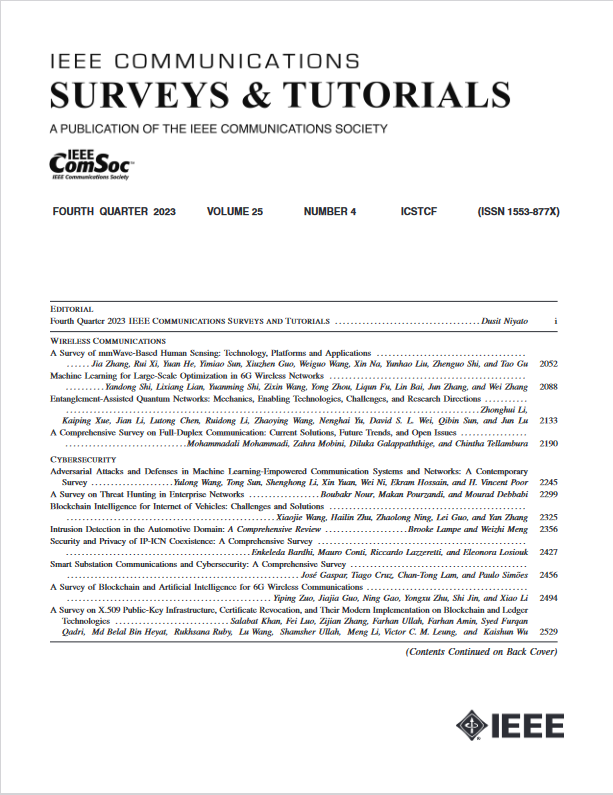Backscatter Communication Meets Practical Battery-Free Internet of Things: A Survey and Outlook
IF 34.4
1区 计算机科学
Q1 COMPUTER SCIENCE, INFORMATION SYSTEMS
引用次数: 2
Abstract
Battery-free Internet-of-Things (BF-IoT), which is realized by harvesting ambient energy to power the IoT devices, has emerged to reduce the energy consumption, and alleviate environmental concerns caused by extensive battery usage. However, current wireless technologies for IoT, such as Bluetooth, ZigBee, and long range radio (LoRa), cannot be efficiently supported by ambient energy due to high power requirement, making them unfit for BF-IoT applications. Backscatter communication (BackCom) is a promising enabling technology for BF-IoT as it achieves microwatt power consumption by eliminating the need of power-hungry radio components such as analog to digital converters. The integration of BF-IoT and BackCom is expected to revolutionize IoT applications and has attracted significant attention recently. However, several fundamental issues need to be addressed to fully harvest the potential of such integration. In this article, we conduct a comprehensive and in-depth survey of BackCom enabled BF-IoT (BackCom-BF-IoT), aiming to provide useful guidance for future research and application from a practical perspective. Specifically, we first introduce the basics of BackCom-BF-IoT by presenting its hardware architecture and key components. Then, we review the existing BackCom-BF-IoT prototypes, from which four fundamental issues related to BackCom are discussed, including link performance enhancement, multi-device concurrent transmission, security guarantee, and interplay between BackCom-BF-IoT system and ambient RF communication systems. For each fundamental issue, we thoroughly review state-of-the-art advances and discuss their prospects for practical BF-IoT applications. Finally, we provide an outlook of future research directions and several case studies.后向散射通信满足实用无电池物联网:调查与展望
无电池物联网(BF IoT)是通过收集环境能量为物联网设备供电来实现的,它已经出现,以减少能源消耗,缓解因大量使用电池而引起的环境问题。然而,当前用于物联网的无线技术,如蓝牙、ZigBee和远程无线电(LoRa),由于高功率要求,无法由环境能源有效支持,使其不适合BF物联网应用。反向散射通信(BackCom)是BF IoT的一种很有前途的使能技术,因为它通过消除对模数转换器等耗电无线电组件的需求来实现微瓦功耗。BF IoT和BackCom的集成有望彻底改变IoT应用,并在最近引起了极大的关注。然而,需要解决几个根本问题,以充分挖掘这种一体化的潜力。在本文中,我们对支持BackCom的BF IoT(BackCom BF IoT)进行了全面深入的调查,旨在从实践的角度为未来的研究和应用提供有用的指导。具体来说,我们首先介绍了BackCom BF IoT的基础知识,介绍了其硬件架构和关键组件。然后,我们回顾了现有的BackCom BF物联网原型,从中讨论了与BackCom相关的四个基本问题,包括链路性能增强、多设备并发传输、安全保障以及BackCom BF-IoT系统与环境RF通信系统之间的相互作用。对于每一个基本问题,我们都会全面回顾最先进的进展,并讨论它们在实际BF物联网应用中的前景。最后,我们对未来的研究方向进行了展望,并进行了几个案例研究。
本文章由计算机程序翻译,如有差异,请以英文原文为准。
求助全文
约1分钟内获得全文
求助全文
来源期刊

IEEE Communications Surveys and Tutorials
COMPUTER SCIENCE, INFORMATION SYSTEMS-TELECOMMUNICATIONS
CiteScore
80.20
自引率
2.50%
发文量
84
审稿时长
6 months
期刊介绍:
IEEE Communications Surveys & Tutorials is an online journal published by the IEEE Communications Society for tutorials and surveys covering all aspects of the communications field. Telecommunications technology is progressing at a rapid pace, and the IEEE Communications Society is committed to providing researchers and other professionals the information and tools to stay abreast. IEEE Communications Surveys and Tutorials focuses on integrating and adding understanding to the existing literature on communications, putting results in context. Whether searching for in-depth information about a familiar area or an introduction into a new area, IEEE Communications Surveys & Tutorials aims to be the premier source of peer-reviewed, comprehensive tutorials and surveys, and pointers to further sources. IEEE Communications Surveys & Tutorials publishes only articles exclusively written for IEEE Communications Surveys & Tutorials and go through a rigorous review process before their publication in the quarterly issues.
A tutorial article in the IEEE Communications Surveys & Tutorials should be designed to help the reader to become familiar with and learn something specific about a chosen topic. In contrast, the term survey, as applied here, is defined to mean a survey of the literature. A survey article in IEEE Communications Surveys & Tutorials should provide a comprehensive review of developments in a selected area, covering its development from its inception to its current state and beyond, and illustrating its development through liberal citations from the literature. Both tutorials and surveys should be tutorial in nature and should be written in a style comprehensible to readers outside the specialty of the article.
 求助内容:
求助内容: 应助结果提醒方式:
应助结果提醒方式:


